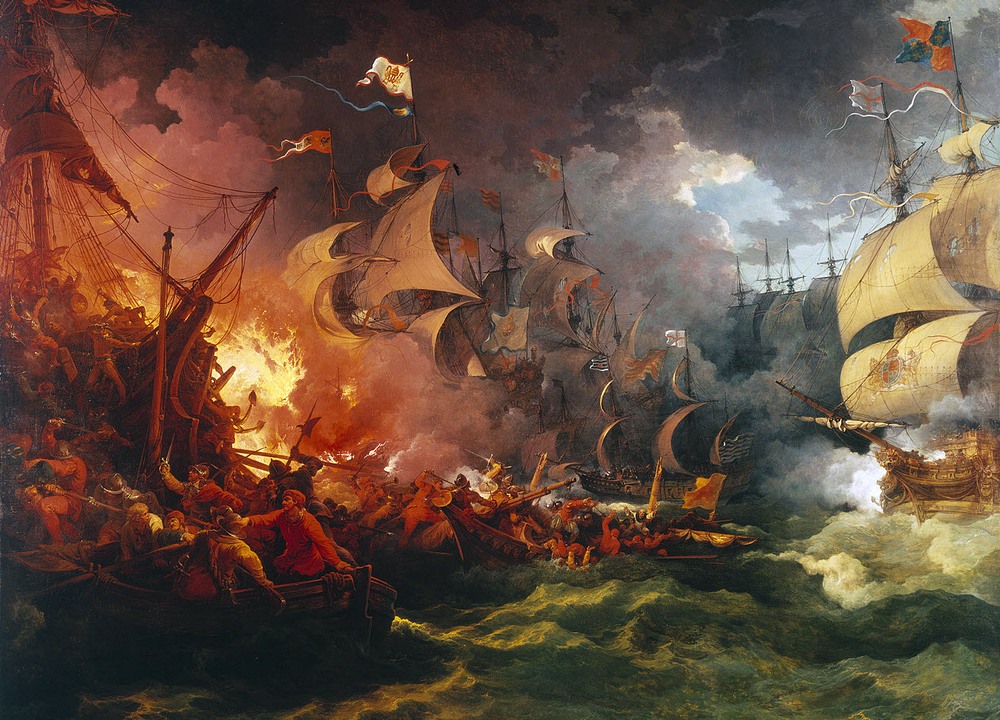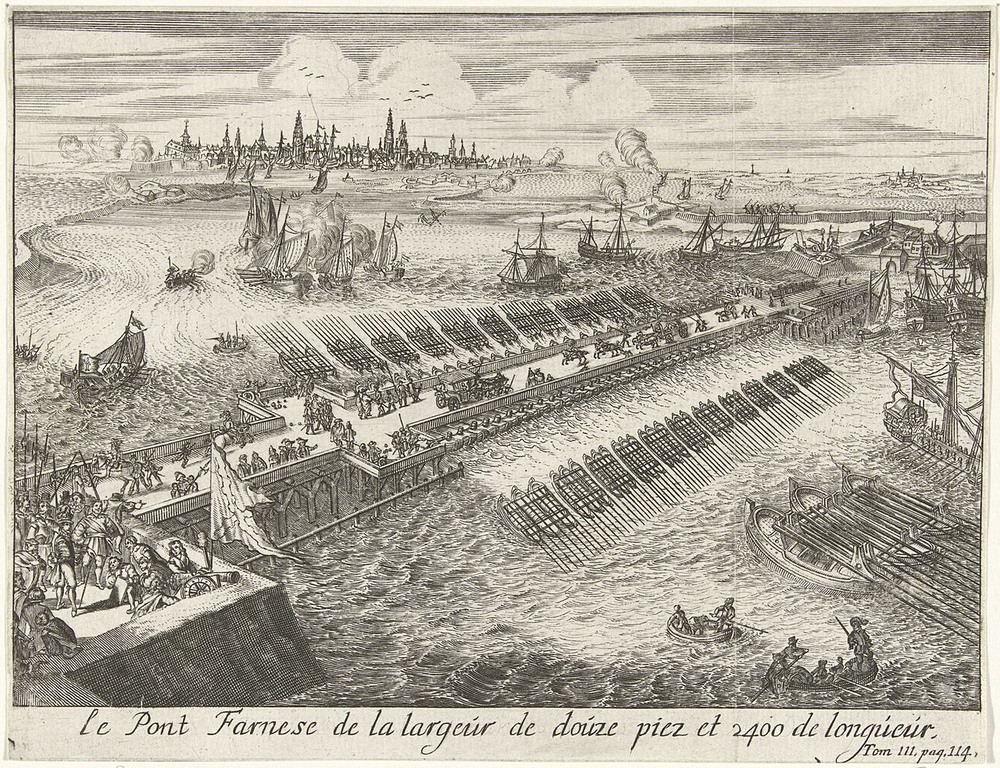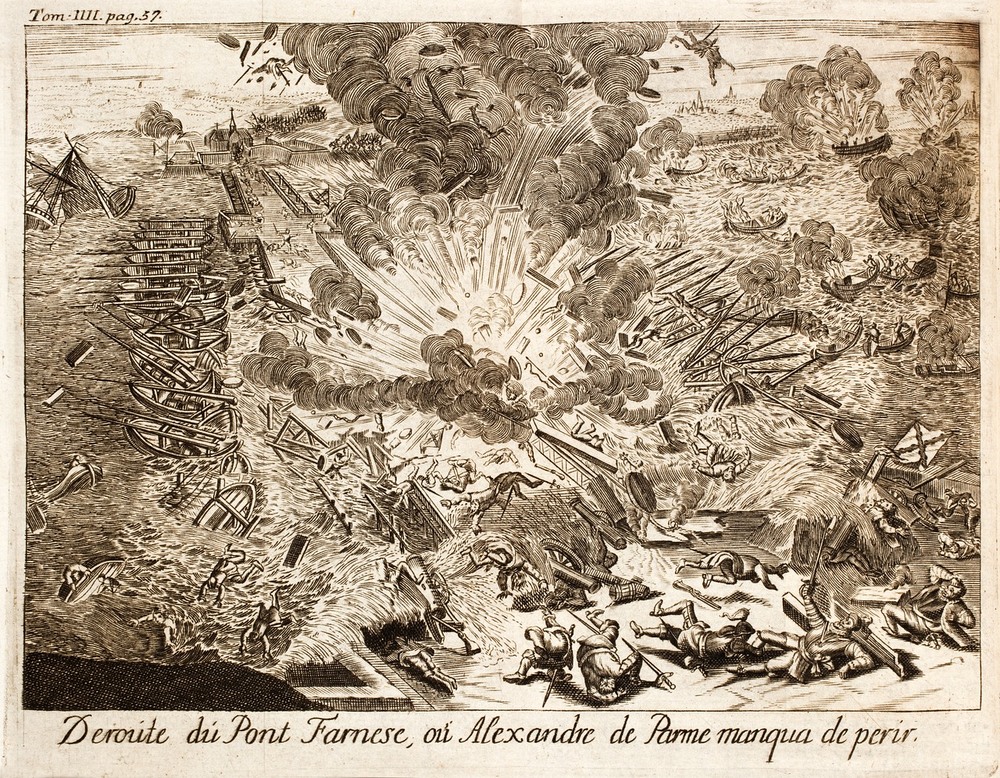In the age of sail, when ships were made of wood, fire was the number one enemy of sailors, and this fearsome tool was used in diabolic ways at times of war to sink enemy ships.
A devious method pioneered by the ancient Greeks was to set on fire one of their own ships, loaded with combustible material such as tar and turpentine, and push it towards the enemy fleet. Such a fireship could wreck havoc upon the enemy with terrifying rapidity. In the 7th century, the Greeks discovered that naptha when mixed with quicklime produced a product so violently combustible that it actually ignited when it came in contact with water. This was the world’s first incendiary weapon, and the Greeks made good use of it on fireships.

Defeat of the Spanish Armada, 8 August 1588, by Philip James de Loutherbourg, 1796
Advancement in shipbuilding and the invention of gunpowder increased the destructive potential of these weapons. Fireships were no longer mere tools to set fire to enemy fleet or docks, but floating bombs designed to destroy as many ships as possible with monstrous explosions.
In the winter of 1585, Antwerp was besieged by the army of Alexander Farnese, the commander of the Habsburg forces in the Spanish Netherlands, who had constructed a bridge across River Scheldt between Antwerp and the sea, effectively closing off the city's waterways. The idea was to starve the population. To break the blockade, the Dutch employed an Italian military engineer named Federigo Giambelli who had gained a considerable reputation for his knowledge in various departments of science.
Giambelli promised that he would destroy the bridge, and demanded that he be handed over three large merchant ships which he selected from the city’s fleet. Giambelli’s request was denied and he was allowed to take only two smaller vessels, named Fortuyn and Hoop. Giambelli was disgusted at the Dutch’s frugality at such a momentous occasion, but at the same time he was determined to make an exhibition of his power even with such limited resources.

The pontoon bridge over the Scheldt built to create a blockade during the siege of Antwerp.
Giambelli turned the two ships into two of the biggest bombs Europe had ever seen up to that time. He called them “hellburners”. Inside the hold of the ships, Giambelli built a “fire chamber” forty feet long and sixteen feet wide with bricks and mortar, and with walls five feet thick. He filled the chamber with 3 tons of high quality corned gunpowder and then sealed it off with a roof made out of old tombstones sealed with lead. On top of the chambers and in the empty spaces around it, he packed a mixture of rocks, iron shards and other projectiles to act as shrapnel. The whole thing was covered with a conventional wooden deck to give the appearance of a regular ship.
On the Fortuyn was deployed a regular delayed fuse—a length of cord that burnt slowly and steadily so that the bomb exploded after a predetermined period of time. The detonator on the Hoop, however, was a technological marvel. Giambelli asked an Antwerp clockmaker to make him a mechanical timer which was combined with a flintlock mechanism to strike, fire, and light the gunpowder hold at a precise time. It was history’s first time bomb.

A hellburner blows up at Antwerp in 1585 during the siege of the city.
Giambelli plan was to send down the river some thirty fireships in successive waves in order to occupy the attention of the Spaniards, until Fortuyn and Hoop could come down upon the bridge. But on the night of the attack, 4 April 1585, the commander in charge of the operation messed up and sent all the fireships at once followed by the two hellburners. The Fortuyn ran aground on the river bank before reaching the bridge. The bomb also fizzled out with only a partial explosion that did little damage to the Spanish forces. The Hoop went straight towards the bridge and struck heavily against it. When the timer ran out, a terrible explosion ripped through the night vaporizing the ship and instantly killing eight hundred Spanish soldiers. A large portion of the bridge also vanished. Moments later, a million shards of gravestones and iron shrapnel that Giambelli had packed inside the ship’s hold rained down from the skies. Houses toppled down miles away, and the sound of the explosion woke up people as far as 35 kilometers away. It was the largest man-made, predetermined explosion up to that time. An effort such as this would not be repeated until the First World War when British Royal Engineers blew up German lines with 450,000 kg of explosives.
Military historian Robert L. O'Connell called hellburners history’s first weapon of mass destruction.
Despite the stunning success of the attack, the Dutch failed to follow up the attack allowing the Spaniards to recover and rebuild the wooden barricade. Antwerp was forced to surrender just four months later.



Comments
Post a Comment